Business Research: Workplace Discrimination at Marks and Spencer
VerifiedAdded on 2023/01/18
|7
|1825
|69
Report
AI Summary
This report presents a research project focused on workplace discrimination, specifically examining Marks and Spencer. The project's aim is to determine ways to reduce discrimination within a business environment. The report includes an introduction outlining the research objectives, background, and rationale for the chosen topic. It delves into the concept of workplace discrimination, its impact on businesses like Marks and Spencer, and strategies to minimize it. The research methodology involves an inductive approach, descriptive research design, and interpretivism philosophy, with both primary and secondary data collection methods, including surveys and literature reviews. The data analysis utilizes thematic analysis, and a random sampling method is employed. Ethical considerations, including data storage, security, and informed consent, are also addressed. The report concludes with a declaration of adherence to ethical guidelines and a comprehensive list of references.

Research project
Paraphrase This Document
Need a fresh take? Get an instant paraphrase of this document with our AI Paraphraser
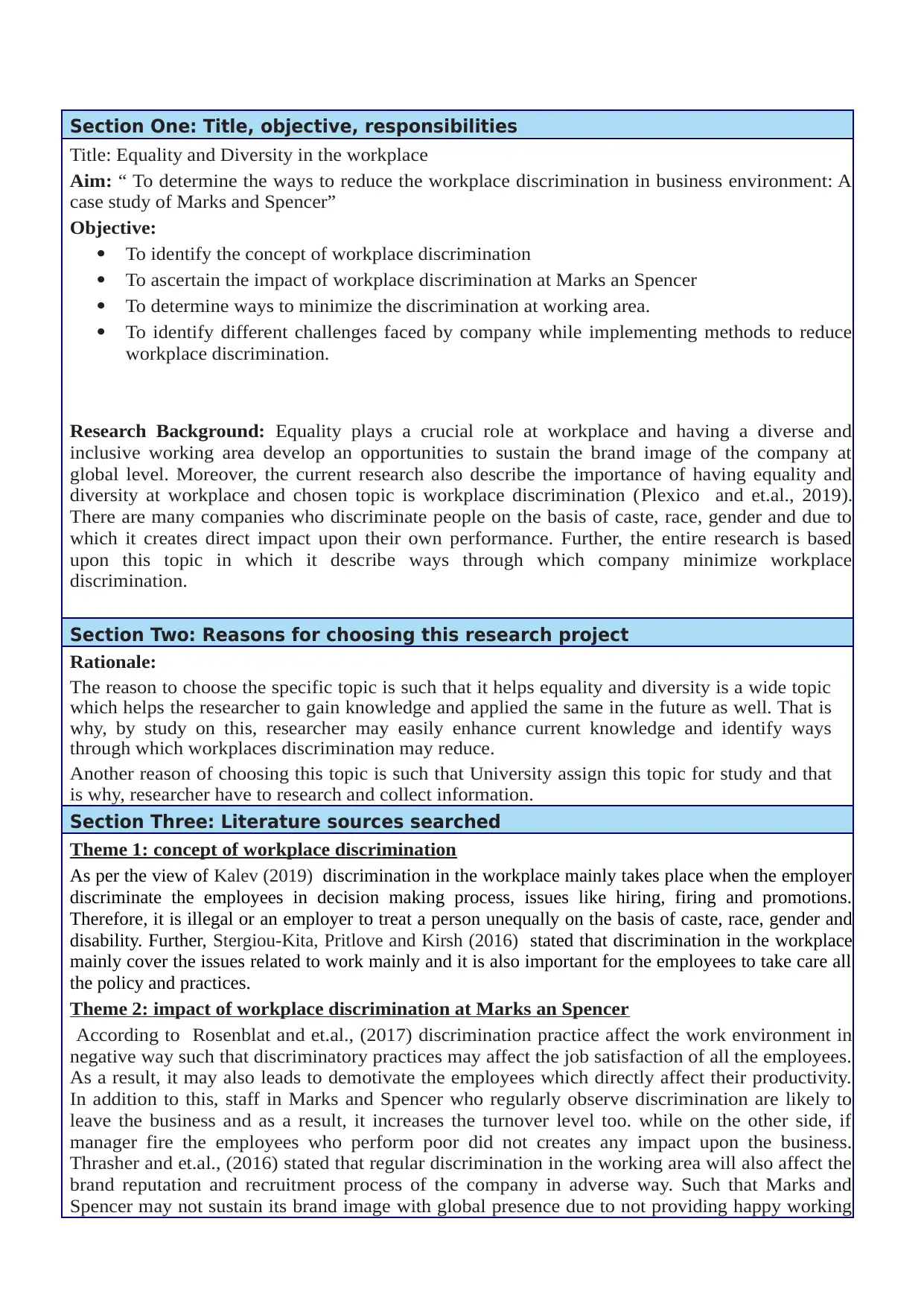
Section One: Title, objective, responsibilities
Title: Equality and Diversity in the workplace
Aim: “ To determine the ways to reduce the workplace discrimination in business environment: A
case study of Marks and Spencer”
Objective:
To identify the concept of workplace discrimination
To ascertain the impact of workplace discrimination at Marks an Spencer
To determine ways to minimize the discrimination at working area.
To identify different challenges faced by company while implementing methods to reduce
workplace discrimination.
Research Background: Equality plays a crucial role at workplace and having a diverse and
inclusive working area develop an opportunities to sustain the brand image of the company at
global level. Moreover, the current research also describe the importance of having equality and
diversity at workplace and chosen topic is workplace discrimination (Plexico and et.al., 2019).
There are many companies who discriminate people on the basis of caste, race, gender and due to
which it creates direct impact upon their own performance. Further, the entire research is based
upon this topic in which it describe ways through which company minimize workplace
discrimination.
Section Two: Reasons for choosing this research project
Rationale:
The reason to choose the specific topic is such that it helps equality and diversity is a wide topic
which helps the researcher to gain knowledge and applied the same in the future as well. That is
why, by study on this, researcher may easily enhance current knowledge and identify ways
through which workplaces discrimination may reduce.
Another reason of choosing this topic is such that University assign this topic for study and that
is why, researcher have to research and collect information.
Section Three: Literature sources searched
Theme 1: concept of workplace discrimination
As per the view of Kalev (2019) discrimination in the workplace mainly takes place when the employer
discriminate the employees in decision making process, issues like hiring, firing and promotions.
Therefore, it is illegal or an employer to treat a person unequally on the basis of caste, race, gender and
disability. Further, Stergiou-Kita, Pritlove and Kirsh (2016) stated that discrimination in the workplace
mainly cover the issues related to work mainly and it is also important for the employees to take care all
the policy and practices.
Theme 2: impact of workplace discrimination at Marks an Spencer
According to Rosenblat and et.al., (2017) discrimination practice affect the work environment in
negative way such that discriminatory practices may affect the job satisfaction of all the employees.
As a result, it may also leads to demotivate the employees which directly affect their productivity.
In addition to this, staff in Marks and Spencer who regularly observe discrimination are likely to
leave the business and as a result, it increases the turnover level too. while on the other side, if
manager fire the employees who perform poor did not creates any impact upon the business.
Thrasher and et.al., (2016) stated that regular discrimination in the working area will also affect the
brand reputation and recruitment process of the company in adverse way. Such that Marks and
Spencer may not sustain its brand image with global presence due to not providing happy working
Title: Equality and Diversity in the workplace
Aim: “ To determine the ways to reduce the workplace discrimination in business environment: A
case study of Marks and Spencer”
Objective:
To identify the concept of workplace discrimination
To ascertain the impact of workplace discrimination at Marks an Spencer
To determine ways to minimize the discrimination at working area.
To identify different challenges faced by company while implementing methods to reduce
workplace discrimination.
Research Background: Equality plays a crucial role at workplace and having a diverse and
inclusive working area develop an opportunities to sustain the brand image of the company at
global level. Moreover, the current research also describe the importance of having equality and
diversity at workplace and chosen topic is workplace discrimination (Plexico and et.al., 2019).
There are many companies who discriminate people on the basis of caste, race, gender and due to
which it creates direct impact upon their own performance. Further, the entire research is based
upon this topic in which it describe ways through which company minimize workplace
discrimination.
Section Two: Reasons for choosing this research project
Rationale:
The reason to choose the specific topic is such that it helps equality and diversity is a wide topic
which helps the researcher to gain knowledge and applied the same in the future as well. That is
why, by study on this, researcher may easily enhance current knowledge and identify ways
through which workplaces discrimination may reduce.
Another reason of choosing this topic is such that University assign this topic for study and that
is why, researcher have to research and collect information.
Section Three: Literature sources searched
Theme 1: concept of workplace discrimination
As per the view of Kalev (2019) discrimination in the workplace mainly takes place when the employer
discriminate the employees in decision making process, issues like hiring, firing and promotions.
Therefore, it is illegal or an employer to treat a person unequally on the basis of caste, race, gender and
disability. Further, Stergiou-Kita, Pritlove and Kirsh (2016) stated that discrimination in the workplace
mainly cover the issues related to work mainly and it is also important for the employees to take care all
the policy and practices.
Theme 2: impact of workplace discrimination at Marks an Spencer
According to Rosenblat and et.al., (2017) discrimination practice affect the work environment in
negative way such that discriminatory practices may affect the job satisfaction of all the employees.
As a result, it may also leads to demotivate the employees which directly affect their productivity.
In addition to this, staff in Marks and Spencer who regularly observe discrimination are likely to
leave the business and as a result, it increases the turnover level too. while on the other side, if
manager fire the employees who perform poor did not creates any impact upon the business.
Thrasher and et.al., (2016) stated that regular discrimination in the working area will also affect the
brand reputation and recruitment process of the company in adverse way. Such that Marks and
Spencer may not sustain its brand image with global presence due to not providing happy working

area to their employees.
Theme 3: ways to minimize the discrimination at working area.
Vickers (2016) stated that encourage workers to respect each other difference and also respond to
any evidence or complaints of inappropriate behaviour. Further, the manager of the company should
also deal with any complaints of discrimination promptly and confidentiality so that they provide
better working environment. Moreover, company may also develop strategies in order to provide
positive working environment to their employees so that they may also provide better outcome for
the welfare of the company.
Theme 4: different challenges faced by company while implementing methods to reduce
workplace discrimination
As per the view of Chavez and et.al., (2015) employment law is consider one of the biggest
challenge while implementing method to reduce the workplace discrimination. As HR and manager
of the company are responsible to complying the laws but due to myriad laws that actually govern
the recruitment, selection and employee retention can be confusing. On the other side, employee
referrals programs which are low cost methods of recruiting potential employees based on the
recommendations from the current employees. This is also consider another challenges which affect
the overall business environment in negative way.
Section Four: Activities and timescales
Gantt chart
Theme 3: ways to minimize the discrimination at working area.
Vickers (2016) stated that encourage workers to respect each other difference and also respond to
any evidence or complaints of inappropriate behaviour. Further, the manager of the company should
also deal with any complaints of discrimination promptly and confidentiality so that they provide
better working environment. Moreover, company may also develop strategies in order to provide
positive working environment to their employees so that they may also provide better outcome for
the welfare of the company.
Theme 4: different challenges faced by company while implementing methods to reduce
workplace discrimination
As per the view of Chavez and et.al., (2015) employment law is consider one of the biggest
challenge while implementing method to reduce the workplace discrimination. As HR and manager
of the company are responsible to complying the laws but due to myriad laws that actually govern
the recruitment, selection and employee retention can be confusing. On the other side, employee
referrals programs which are low cost methods of recruiting potential employees based on the
recommendations from the current employees. This is also consider another challenges which affect
the overall business environment in negative way.
Section Four: Activities and timescales
Gantt chart
⊘ This is a preview!⊘
Do you want full access?
Subscribe today to unlock all pages.

Trusted by 1+ million students worldwide
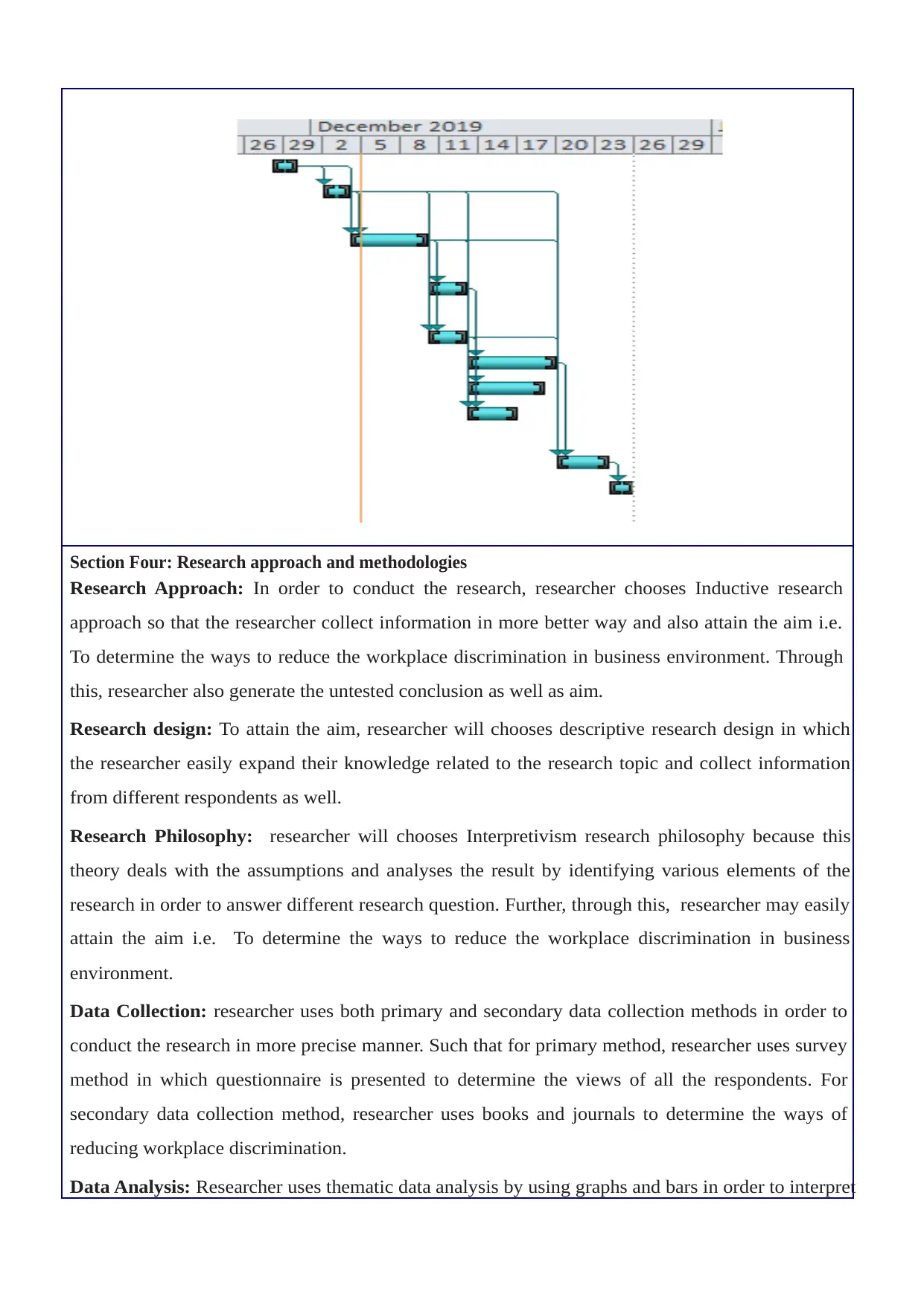
Section Four: Research approach and methodologies
Research Approach: In order to conduct the research, researcher chooses Inductive research
approach so that the researcher collect information in more better way and also attain the aim i.e.
To determine the ways to reduce the workplace discrimination in business environment. Through
this, researcher also generate the untested conclusion as well as aim.
Research design: To attain the aim, researcher will chooses descriptive research design in which
the researcher easily expand their knowledge related to the research topic and collect information
from different respondents as well.
Research Philosophy: researcher will chooses Interpretivism research philosophy because this
theory deals with the assumptions and analyses the result by identifying various elements of the
research in order to answer different research question. Further, through this, researcher may easily
attain the aim i.e. To determine the ways to reduce the workplace discrimination in business
environment.
Data Collection: researcher uses both primary and secondary data collection methods in order to
conduct the research in more precise manner. Such that for primary method, researcher uses survey
method in which questionnaire is presented to determine the views of all the respondents. For
secondary data collection method, researcher uses books and journals to determine the ways of
reducing workplace discrimination.
Data Analysis: Researcher uses thematic data analysis by using graphs and bars in order to interpret
Research Approach: In order to conduct the research, researcher chooses Inductive research
approach so that the researcher collect information in more better way and also attain the aim i.e.
To determine the ways to reduce the workplace discrimination in business environment. Through
this, researcher also generate the untested conclusion as well as aim.
Research design: To attain the aim, researcher will chooses descriptive research design in which
the researcher easily expand their knowledge related to the research topic and collect information
from different respondents as well.
Research Philosophy: researcher will chooses Interpretivism research philosophy because this
theory deals with the assumptions and analyses the result by identifying various elements of the
research in order to answer different research question. Further, through this, researcher may easily
attain the aim i.e. To determine the ways to reduce the workplace discrimination in business
environment.
Data Collection: researcher uses both primary and secondary data collection methods in order to
conduct the research in more precise manner. Such that for primary method, researcher uses survey
method in which questionnaire is presented to determine the views of all the respondents. For
secondary data collection method, researcher uses books and journals to determine the ways of
reducing workplace discrimination.
Data Analysis: Researcher uses thematic data analysis by using graphs and bars in order to interpret
Paraphrase This Document
Need a fresh take? Get an instant paraphrase of this document with our AI Paraphraser
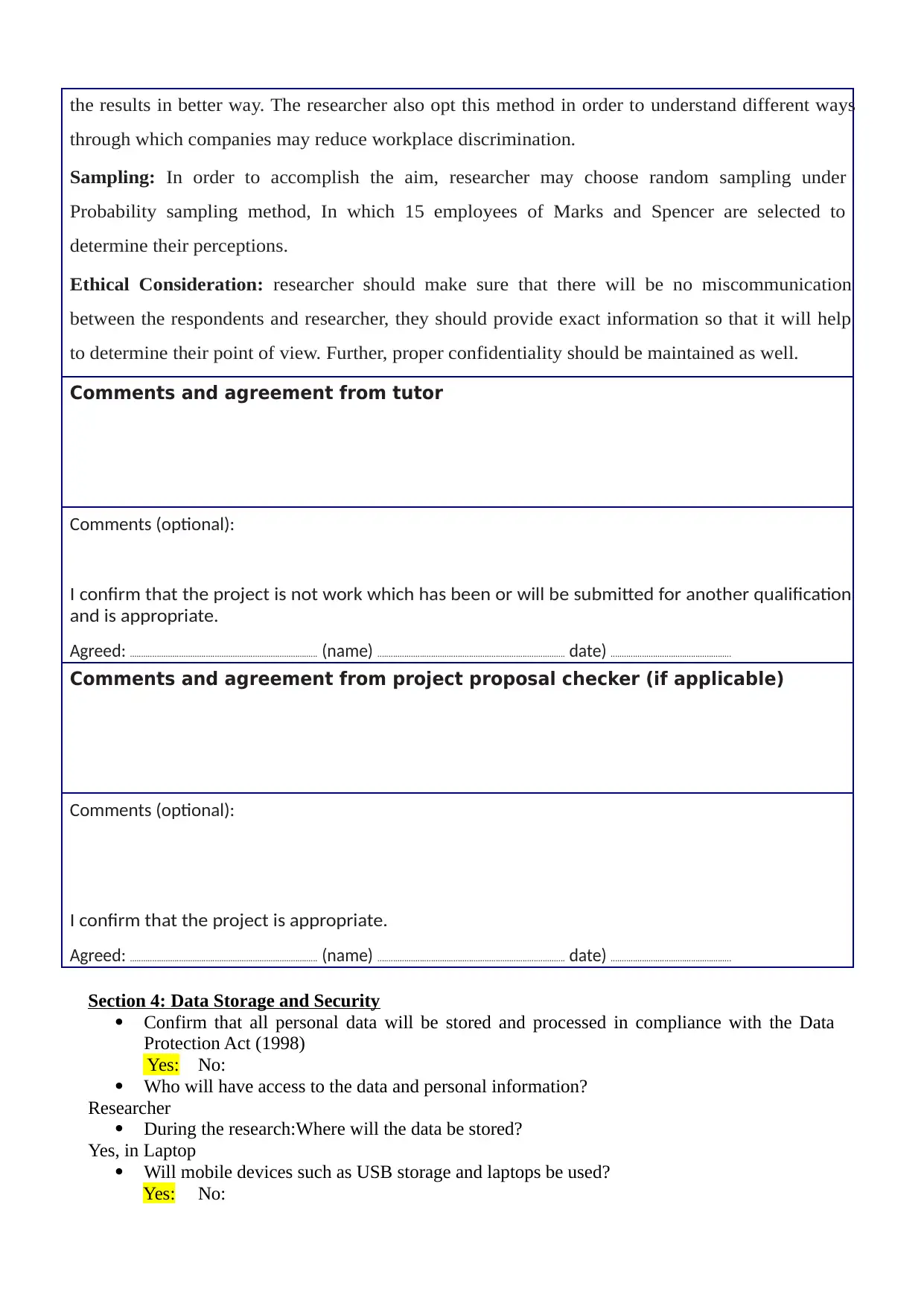
the results in better way. The researcher also opt this method in order to understand different ways
through which companies may reduce workplace discrimination.
Sampling: In order to accomplish the aim, researcher may choose random sampling under
Probability sampling method, In which 15 employees of Marks and Spencer are selected to
determine their perceptions.
Ethical Consideration: researcher should make sure that there will be no miscommunication
between the respondents and researcher, they should provide exact information so that it will help
to determine their point of view. Further, proper confidentiality should be maintained as well.
Comments and agreement from tutor
Comments (optional):
I confirm that the project is not work which has been or will be submitted for another qualification
and is appropriate.
Agreed: .................................................................................... (name) .................................................................................... date) ......................................................
Comments and agreement from project proposal checker (if applicable)
Comments (optional):
I confirm that the project is appropriate.
Agreed: .................................................................................... (name) .................................................................................... date) ......................................................
Section 4: Data Storage and Security
Confirm that all personal data will be stored and processed in compliance with the Data
Protection Act (1998)
Yes: No:
Who will have access to the data and personal information?
Researcher
During the research:Where will the data be stored?
Yes, in Laptop
Will mobile devices such as USB storage and laptops be used?
Yes: No:
through which companies may reduce workplace discrimination.
Sampling: In order to accomplish the aim, researcher may choose random sampling under
Probability sampling method, In which 15 employees of Marks and Spencer are selected to
determine their perceptions.
Ethical Consideration: researcher should make sure that there will be no miscommunication
between the respondents and researcher, they should provide exact information so that it will help
to determine their point of view. Further, proper confidentiality should be maintained as well.
Comments and agreement from tutor
Comments (optional):
I confirm that the project is not work which has been or will be submitted for another qualification
and is appropriate.
Agreed: .................................................................................... (name) .................................................................................... date) ......................................................
Comments and agreement from project proposal checker (if applicable)
Comments (optional):
I confirm that the project is appropriate.
Agreed: .................................................................................... (name) .................................................................................... date) ......................................................
Section 4: Data Storage and Security
Confirm that all personal data will be stored and processed in compliance with the Data
Protection Act (1998)
Yes: No:
Who will have access to the data and personal information?
Researcher
During the research:Where will the data be stored?
Yes, in Laptop
Will mobile devices such as USB storage and laptops be used?
Yes: No:
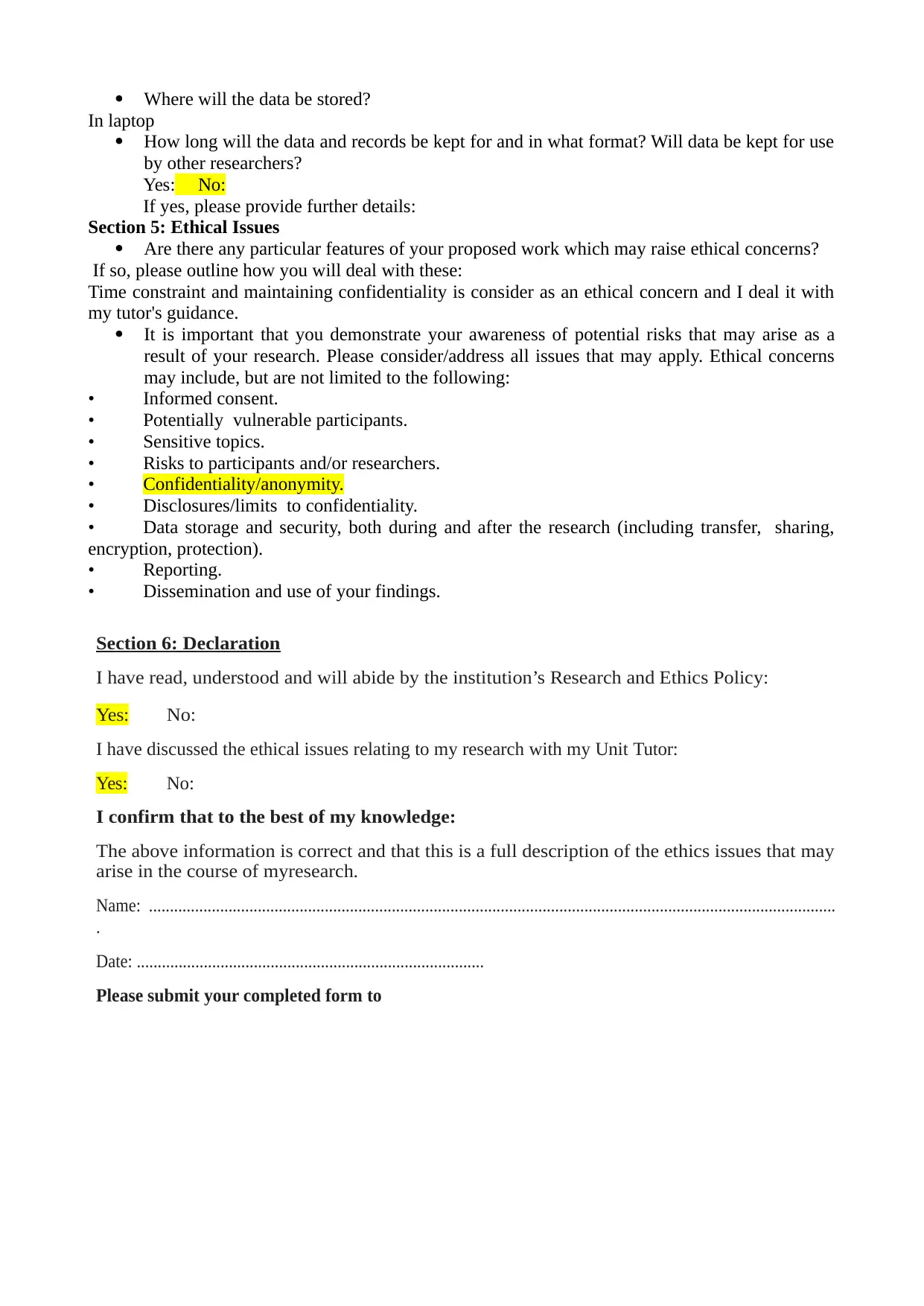
Where will the data be stored?
In laptop
How long will the data and records be kept for and in what format? Will data be kept for use
by other researchers?
Yes: No:
If yes, please provide further details:
Section 5: Ethical Issues
Are there any particular features of your proposed work which may raise ethical concerns?
If so, please outline how you will deal with these:
Time constraint and maintaining confidentiality is consider as an ethical concern and I deal it with
my tutor's guidance.
It is important that you demonstrate your awareness of potential risks that may arise as a
result of your research. Please consider/address all issues that may apply. Ethical concerns
may include, but are not limited to the following:
• Informed consent.
• Potentially vulnerable participants.
• Sensitive topics.
• Risks to participants and/or researchers.
• Confidentiality/anonymity.
• Disclosures/limits to confidentiality.
• Data storage and security, both during and after the research (including transfer, sharing,
encryption, protection).
• Reporting.
• Dissemination and use of your findings.
Section 6: Declaration
I have read, understood and will abide by the institution’s Research and Ethics Policy:
Yes: No:
I have discussed the ethical issues relating to my research with my Unit Tutor:
Yes: No:
I confirm that to the best of my knowledge:
The above information is correct and that this is a full description of the ethics issues that may
arise in the course of myresearch.
Name: ....................................................................................................................................................................
.
Date: ...................................................................................
Please submit your completed form to
In laptop
How long will the data and records be kept for and in what format? Will data be kept for use
by other researchers?
Yes: No:
If yes, please provide further details:
Section 5: Ethical Issues
Are there any particular features of your proposed work which may raise ethical concerns?
If so, please outline how you will deal with these:
Time constraint and maintaining confidentiality is consider as an ethical concern and I deal it with
my tutor's guidance.
It is important that you demonstrate your awareness of potential risks that may arise as a
result of your research. Please consider/address all issues that may apply. Ethical concerns
may include, but are not limited to the following:
• Informed consent.
• Potentially vulnerable participants.
• Sensitive topics.
• Risks to participants and/or researchers.
• Confidentiality/anonymity.
• Disclosures/limits to confidentiality.
• Data storage and security, both during and after the research (including transfer, sharing,
encryption, protection).
• Reporting.
• Dissemination and use of your findings.
Section 6: Declaration
I have read, understood and will abide by the institution’s Research and Ethics Policy:
Yes: No:
I have discussed the ethical issues relating to my research with my Unit Tutor:
Yes: No:
I confirm that to the best of my knowledge:
The above information is correct and that this is a full description of the ethics issues that may
arise in the course of myresearch.
Name: ....................................................................................................................................................................
.
Date: ...................................................................................
Please submit your completed form to
⊘ This is a preview!⊘
Do you want full access?
Subscribe today to unlock all pages.

Trusted by 1+ million students worldwide
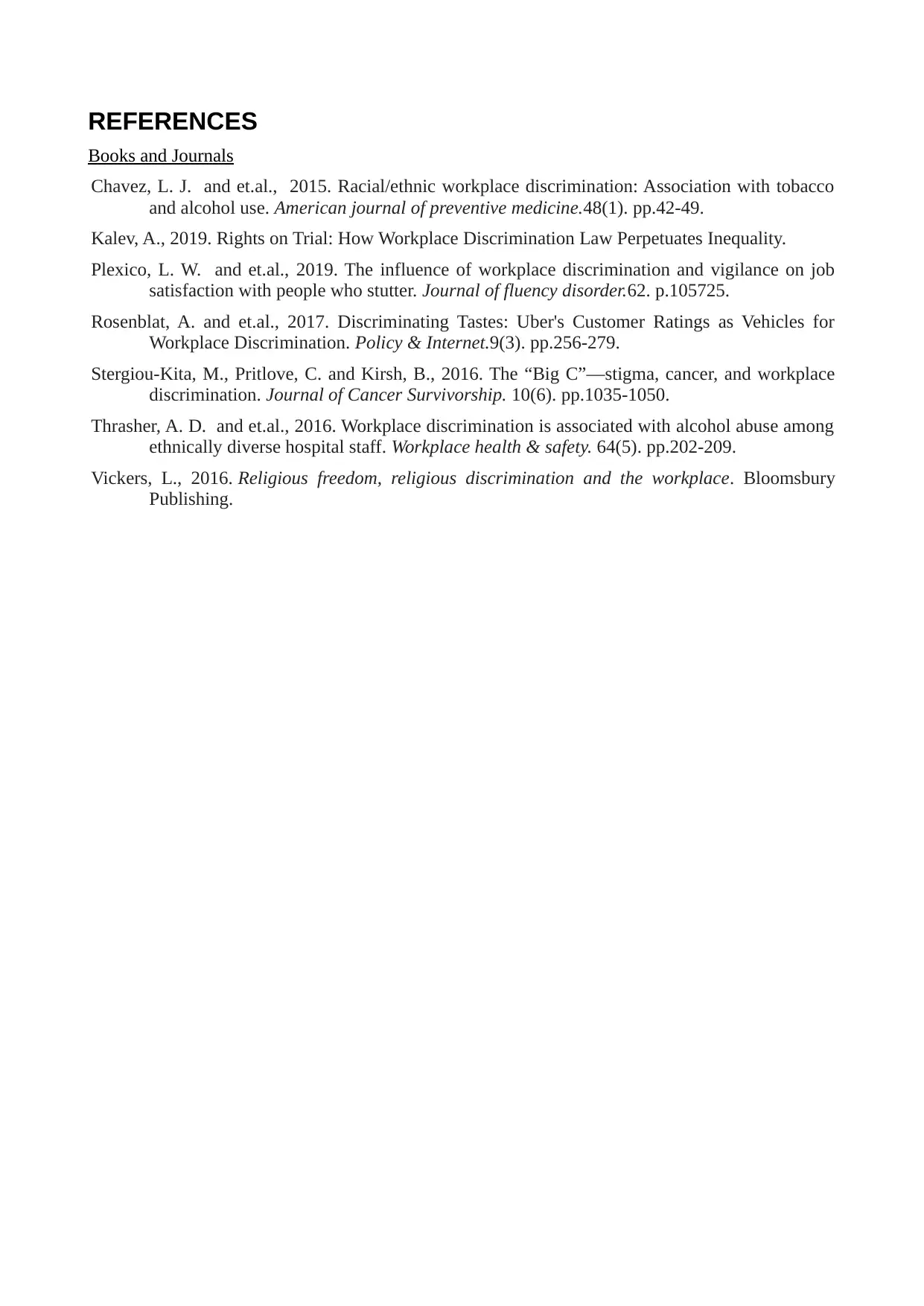
REFERENCES
Books and Journals
Chavez, L. J. and et.al., 2015. Racial/ethnic workplace discrimination: Association with tobacco
and alcohol use. American journal of preventive medicine.48(1). pp.42-49.
Kalev, A., 2019. Rights on Trial: How Workplace Discrimination Law Perpetuates Inequality.
Plexico, L. W. and et.al., 2019. The influence of workplace discrimination and vigilance on job
satisfaction with people who stutter. Journal of fluency disorder.62. p.105725.
Rosenblat, A. and et.al., 2017. Discriminating Tastes: Uber's Customer Ratings as Vehicles for
Workplace Discrimination. Policy & Internet.9(3). pp.256-279.
Stergiou-Kita, M., Pritlove, C. and Kirsh, B., 2016. The “Big C”—stigma, cancer, and workplace
discrimination. Journal of Cancer Survivorship. 10(6). pp.1035-1050.
Thrasher, A. D. and et.al., 2016. Workplace discrimination is associated with alcohol abuse among
ethnically diverse hospital staff. Workplace health & safety. 64(5). pp.202-209.
Vickers, L., 2016. Religious freedom, religious discrimination and the workplace. Bloomsbury
Publishing.
Books and Journals
Chavez, L. J. and et.al., 2015. Racial/ethnic workplace discrimination: Association with tobacco
and alcohol use. American journal of preventive medicine.48(1). pp.42-49.
Kalev, A., 2019. Rights on Trial: How Workplace Discrimination Law Perpetuates Inequality.
Plexico, L. W. and et.al., 2019. The influence of workplace discrimination and vigilance on job
satisfaction with people who stutter. Journal of fluency disorder.62. p.105725.
Rosenblat, A. and et.al., 2017. Discriminating Tastes: Uber's Customer Ratings as Vehicles for
Workplace Discrimination. Policy & Internet.9(3). pp.256-279.
Stergiou-Kita, M., Pritlove, C. and Kirsh, B., 2016. The “Big C”—stigma, cancer, and workplace
discrimination. Journal of Cancer Survivorship. 10(6). pp.1035-1050.
Thrasher, A. D. and et.al., 2016. Workplace discrimination is associated with alcohol abuse among
ethnically diverse hospital staff. Workplace health & safety. 64(5). pp.202-209.
Vickers, L., 2016. Religious freedom, religious discrimination and the workplace. Bloomsbury
Publishing.
1 out of 7
Related Documents
Your All-in-One AI-Powered Toolkit for Academic Success.
+13062052269
info@desklib.com
Available 24*7 on WhatsApp / Email
![[object Object]](/_next/static/media/star-bottom.7253800d.svg)
Unlock your academic potential
Copyright © 2020–2025 A2Z Services. All Rights Reserved. Developed and managed by ZUCOL.





